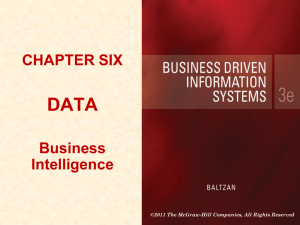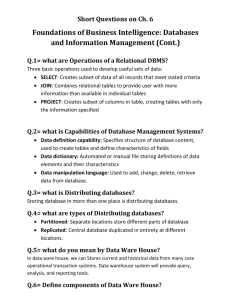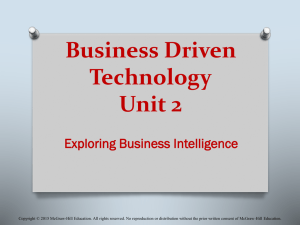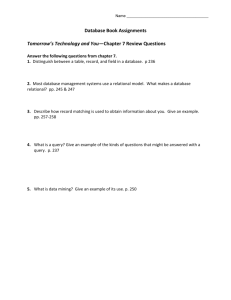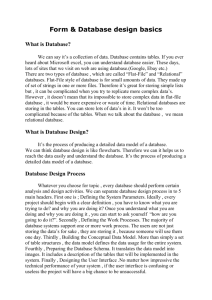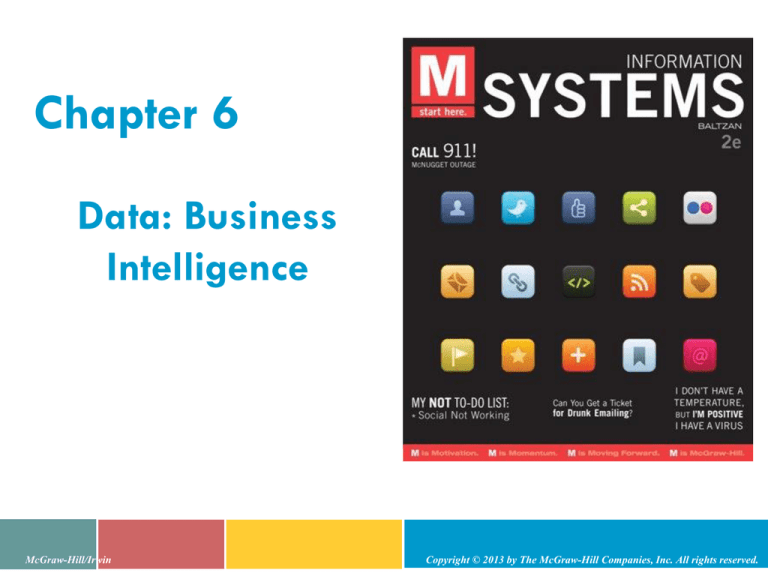
Chapter 6
Data: Business
Intelligence
McGraw-Hill/Irwin
Copyright © 2013 by The McGraw-Hill Companies, Inc. All rights reserved.
CHAPTER OVERVIEW
Chapter 6
• SECTION 6.1 – Data, Information, Databases
The Business Benefits of High-Quality Information
Storing Information Using a Relational Database
Management System
Using a Relational Database for Business Advantages
Driving Websites with Data
• SECTION 6.2 – Business Intelligence
The Business Benefits of Data Warehousing
Performing Business Analysis with Data Marts
Uncovering Trends and Patterns with Data Mining
Supporting Decisions with Business Intelligence
6-2
Chapter 6
SECTION 6.1
DATA, INFORMATION, AND
DATABASES
6-3
LEARNING OUTCOMES
Chapter 6
1.
Explain the four primary traits that determine the
value of information
2.
Describe a database, a database management
system, and the relational database model
3.
Identify the business advantages of a relational
database
4.
Explain the business benefits of a data-driven
website
6-4
THE BUSINESS BENEFITS OF HIGHQUALITY INFORMATION
Chapter 6
• Information is everywhere in an organization
• Employees must be able to obtain and analyze
the many different levels, formats, and
granularities of organizational information to
make decisions
• Successfully collecting, compiling, sorting, and
analyzing information can provide tremendous
insight into how an organization is performing
6-5
THE BUSINESS BENEFITS OF HIGHQUALITY INFORMATION
Chapter 6
Levels, Formats, and Granularities of Information
6-6
Information Type:
Transactional and Analytical
Chapter 6
• Transactional information – Encompasses all of
the information contained within a single
business process or unit of work, and its primary
purpose is to support the performing of daily
operational tasks
• Analytical information – Encompasses all
organizational information, and its primary
purpose is to support the performing of
managerial analysis tasks
6-7
Information Type:
Transactional and Analytical
Chapter 6
6-8
Information Timeliness
Chapter 6
• Timeliness is an aspect of information that
depends on the situation
Real-time information – Immediate, up-to-date
information
Real-time system – Provides real-time information
in response to requests
6-9
Information Quality
Chapter 6
• Business decisions are only as good as the quality of
the information used to make the decisions
• You never want to find yourself using technology to
help you make a bad decision faster
6-10
Information Quality
Chapter 6
• Characteristics of High-quality Information
Accurate
Complete
Consistent
Unique
Timely
6-11
Information Quality
Chapter 6
Low Quality Information Example
6-12
Understanding the Costs of
Using Low-Quality Information
Chapter 6
•
The four primary sources of low-quality
information include
1.
Customers intentionally enter inaccurate
information to protect their privacy
2.
Different entry standards and formats
3.
Operators enter abbreviated or erroneous
information by accident or to save time
4.
Third party and external information contains
inconsistencies, inaccuracies, and errors
6-13
Understanding the Costs of
Using Low-Quality Information
Chapter 6
• Potential business effects resulting from low-
quality information include
Inability to accurately track customers
Difficulty identifying valuable customers
Inability to identify selling opportunities
Marketing to nonexistent customers
Difficulty tracking revenue
Inability to build strong customer relationships
6-14
Understanding the Benefits of
Good Information
Chapter 6
• High-quality information can
significantly improve the chances of
making a good decision
• Good decisions can directly impact an
organization's bottom line
6-15
STORING INFORMATION IN A
RELATIONAL DATABASE
Chapter 6
• Information is everywhere in an
organization
• Information is stored in databases
Database – maintains information
about various types of objects
(inventory), events (transactions),
people (employees), and places
(warehouses)
6-16
STORING INFORMATION IN A
RELATIONAL DATABASE
Chapter 6
• Database management systems (DBMS) – Allows users to
create, read, update, and delete data in a relational
database
6-17
STORING INFORMATION IN A
RELATIONAL DATABASE
Chapter 6
• Data element – The smallest or basic unit
of information
• Data model – Logical data structures that
detail the relationships among data
elements using graphics or pictures
• Metadata – Provides details about data
• Data dictionary – Compiles all of the
metadata about the data elements in the
data model
6-18
Storing Data Elements in
Entities and Attributes
Chapter 6
• Entity – A person, place, thing,
transaction, or event about which
information is stored
The rows in a table contain entities
• Attribute (field, column) – The data
elements associated with an entity
The columns in each table contain the
attributes
• Record – A collection of related data
elements
6-19
Creating Relationships
Through Keys
Chapter 6
• Primary keys and foreign keys identify
the various entities (tables) in the
database
Primary key – A field (or group of fields)
that uniquely identifies a given entity in a
table
Foreign key – A primary key of one table
that appears an attribute in another table
and acts to provide a logical relationship
among the two tables
6-20
USING A RELATIONAL DATABASE FOR
BUSINESS ADVANTAGES
Chapter 6
• Database advantages from a
business perspective include
Increased flexibility
Increased scalability and performance
Reduced information redundancy
Increased information integrity (quality)
Increased information security
6-21
Increased Flexibility
Chapter 6
• A well-designed database should
Handle changes quickly and easily
Provide users with different views
Have only one physical view
Physical view – Deals with the physical
storage of information on a storage
device
Have multiple logical views
o Logical view – Focuses on how individual
users logically access information to meet
their own particular business needs
o
6-22
Increased Scalability and
Performance
Chapter 6
• A database must scale to meet
increased demand, while
maintaining acceptable performance
levels
Scalability – Refers to how well a
system can adapt to increased demands
Performance – Measures how quickly a
system performs a certain process or
transaction
6-23
Reduced Data Redundancy
Chapter 6
• Databases reduce data redundancy
Data redundancy – The duplication of data or storing the
same information in multiple places
• Inconsistency is one of the primary problems with
redundant information
6-24
Increase Information
Integrity (Quality)
Chapter 6
• Information integrity – measures the quality of
information
• Integrity constraint – rules that help ensure the
quality of information
Relational integrity constraint
Business-critical integrity constraint
6-25
Increased Information Security
Chapter 6
• Information is an organizational asset
and must be protected
• Databases offer several security
features
Password – Provides authentication of the
user
Access level – Determines who has access
to the different types of information
Access control – Determines types of user
access, such as read-only access
6-26
DRIVING WEBSITES
WITH DATA
Chapter 6
• Data-driven websites – An interactive
website kept constantly updated and
relevant to the needs of its customers
using a database
6-27
DRIVING WEBSITES
WITH DATA
Chapter 6
6-28
DRIVING WEBSITES
WITH DATA
Chapter 6
• Data-driven website advantages
Easy to manage content
Easy to store large amounts of data
Easy to eliminate human errors
6-29
DRIVING WEBSITES
WITH DATA
Chapter 6
6-30
Chapter 6
SECTION 6.2
BUSINESS INTELLIGENCE
6-31
LEARNING OUTCOMES
Chapter 6
5. Define a data warehouse and provide a few reasons it
can make a manager more effective
6. Explain ETL and the role of a data mart in business
7. Define data mining and explain the three common
forms for mining structured and unstructured data
8. Identify the advantages of using business intelligence to
support managerial decision making
6-32
THE BUSINESS BENEFITS OF
DATA WAREHOUSING
Chapter 6
• Data warehouses extend the
transformation of data into information
• In the 1990s, executives became less
concerned with the day-to-day business
operations and more concerned with
overall business functions
• The data warehouse provided the ability
to support decision making without
disrupting the day-to-day operations
6-33
THE BUSINESS BENEFITS OF
DATA WAREHOUSING
Chapter 6
• Data warehouse – A logical collection
of information – gathered from many
different operational databases – that
supports business analysis activities and
decision-making tasks
• The primary purpose of a data
warehouse is to aggregate information
throughout an organization into a single
repository for decision-making purposes
6-34
PERFORMING BUSINESS ANALYSIS WITH
DATA MARTS
Chapter 6
• Extraction, transformation, and loading (ETL) – A
process that extracts information from internal and
external databases, transforms the information using a
common set of enterprise definitions, and loads the
information into a data warehouse
• Data mart – Contains a subset of data warehouse
information
6-35
PERFORMING BUSINESS ANALYSIS WITH
DATA MARTS
Chapter 6
6-36
Multidimensional Analysis
Chapter 6
• Databases contain information in a series of
two-dimensional tables
• In a data warehouse and data mart, information
is multidimensional; it contains layers of columns
and rows
Dimension – A particular attribute of information
Cube – Common term for the representation of
multidimensional information
6-37
Multidimensional Analysis
Chapter 6
Cubes of Information
6-38
Information Cleansing
or Scrubbing
Chapter 6
• An organization must maintain high-quality data in the
data warehouse
• Information cleansing or scrubbing – A process that
weeds out and fixes or discards inconsistent, incorrect,
or incomplete information
6-39
Information Cleansing
or Scrubbing
Chapter 6
Contact Information in an Operational System
6-40
Information Cleansing
or Scrubbing
Chapter 6
Standardizing Customer Name from Operational Systems
6-41
Information Cleansing
or Scrubbing
Chapter 6
Information Cleansing Example
6-42
Information Cleansing
or Scrubbing
Chapter 6
Cost of Accurate and Complete Information
6-43
UNCOVERING TRENDS AND PATTERNS
WITH DATA MINING
Chapter 6
• Data mining – The process of analyzing data to extract
information not offered by the raw data alone
• Data-mining tools – use a variety of techniques to find
patterns and relationships in large volumes of information
Classification
Estimation
Affinity grouping
Clustering
6-44
UNCOVERING TRENDS AND PATTERNS
WITH DATA MINING
Chapter 6
• Structured data – Data already in a database or
a spreadsheet
• Unstructured data – Data does not exist in a
fixed location and can include text documents,
PDFs, voice messages, emails
• Text mining – Analyzes unstructured data to find
trends and patterns in words and sentences
• Web mining – Analyzes unstructured data
associated with websites to identify consumer
behavior and website navigation
6-45
UNCOVERING TRENDS AND PATTERNS
WITH DATA MINING
Chapter 6
Common forms of data-mining analysis capabilities
include
•
Cluster analysis
Association detection
Statistical analysis
6-46
Cluster Analysis
Chapter 6
•
Cluster analysis – A technique used to divide an
information set into mutually exclusive groups such that
the members of each group are as close together as
possible to one another and the different groups are as
far apart as possible
6-47
Association Detection
Chapter 6
Association detection – Reveals the relationship
between variables along with the nature and
frequency of the relationships
•
Market basket analysis
6-48
Statistical Analysis
Chapter 6
Statistical analysis – Performs
such functions as information
correlations, distributions,
calculations, and variance analysis
•
Forecast – Predictions made on the
basis of time-series information
Time-series information – Timestamped information collected at a
particular frequency
6-49
The Problem:
Data Rich, Information Poor
Chapter 6
• Businesses face a data explosion as
digital images, email in-boxes, and
broadband connections doubles by
2010
• The amount of data generated is
doubling every year
• Some believe it will soon double monthly
6-50
The Solution: Business Intelligence
Chapter 6
• Improving the quality of business decisions has a direct
impact on costs and revenue
• BI enables business users to receive data for analysis
that is:
Reliable
Consistent
Understandable
Easily manipulated
6-51
The Solution: Business Intelligence
Chapter 6
BI Can Answer Tough Questions
6-52

